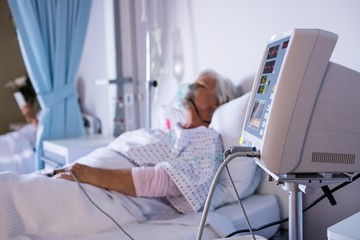This medical equipment, needed in clinics and hospitals, is used to monitor and control the vital signs of the patient connected to the apparatus and which requires continuous supervision; this device detects, processes and records the physiological and cardiac parameters of the patient, the design of these equipment should be simple to facilitate its use by medical staff, nurses and paramedics.
Each function must be separated in order to be replaced individually if there is a fault; they must be easy to operate and their functions must be easy to learn, so an ergonomic and simple design is required, we at KALSTEIN can offer you these features on the monitors.
Values recorded by a vital signs monitor.
- Heart rate: they are two noises and must be rhythmic and regular, occurring 60 to 100 times in a minute, the latter being called heart rate.
- Blood pressure: The blood pressure reading uses two numbers. Generally, the systolic number is placed before or above the diastolic number.
- Pulse: number of heartbeats per minute.
- Oxygen saturation: It’s the amount of oxygen available in the blood.
- Body temperature: Body temperature measurement can detect a disease, effectiveness of treatment, or if it corresponds to a fever.
General characteristics of a patient monitor.
- Modular system, flexible and open to new developments.
- Graphical user interface.
- Configurable and customizable.
- Detection, storage and classification of arrhythmias.
- Storage of 24 h trends.
- Visual and sound alarm systems.
Parts of a vital signs monitor.
- Visual alarm.
- ECG signal display.
- SpO2 signal display.
- Display of breath signal.
- Handle to transport it.
- Power button.
- Start and stop taking NPI.
- Selection Control.
How to read a vital signs monitor
A vital signs monitor must be handled by specialized medical personnel, some can be programmed and configured manually with the data we require, set parameters and set alarms, others are already factory configured; however, we must observe the graph of an electrocardiogram, also to read the alterations of the invasive and non-invasive blood pressure, the saturation of oxygen in the blood, the body temperature, intracranial pressure, among other values for which it has been configured.
All recorded values appear on the monitor, so we must know that 20/80 means that you have a systolic pressure of 120 and a diastolic pressure of 80; proper saturation levels cause the body’s cells to receive the right amount of oxygen, the alarms they report when these parameters come out of what are considered normal values.
KALSTEIN-branded patient monitors.
- Patient monitor YR02161: color LED display, alarm limits are adjustable and its rechargeable battery lasts up to 4 hours.
- Doppler Fetal Ultrasound Monitor YR02181: 7-wafer pulse ultrasound transducer, configured with a special heart rate autocorrelation reading algorithm to ensure correct and reliable measurement of fetal heart rate (FCF).
- YR02180 Fetal Doppler Monitor: High sensitivity multi-wafer pulse ultrasound transducer, MHZ working mode, easy to obtain the FHR.
- Multiparameter Patient Monitor YR02178/YR02179: Visual and sound alarm with three-color alarm light.
- Patient Monitor YR02175/YR02176/YR02177: anesthetic depth monitoring modules and EtCO2 available.
- YR02173/YR02174 Head Monitor: continuous long-term monitoring and real-time attention to several physiological parameters.
- Patient monitor YR02170/YR02172: Single adjustable breathing cable to increase the accuracy of monitoring of neonatal patient.
- Vital Signs Monitor YR02164: accurate and simple assessment of vital signs or for continuous monitoring.
We offer you more information about the different types of patient monitors, their models and features; at the following link HERE; do not hesitate to contact us KALSTEIN through the website, we are a company manufacturer of laboratory equipment with international coverage with the best offers in online sales/purchase, if you have doubts about which purchase, we will help you, in addition to offering you the best products.

